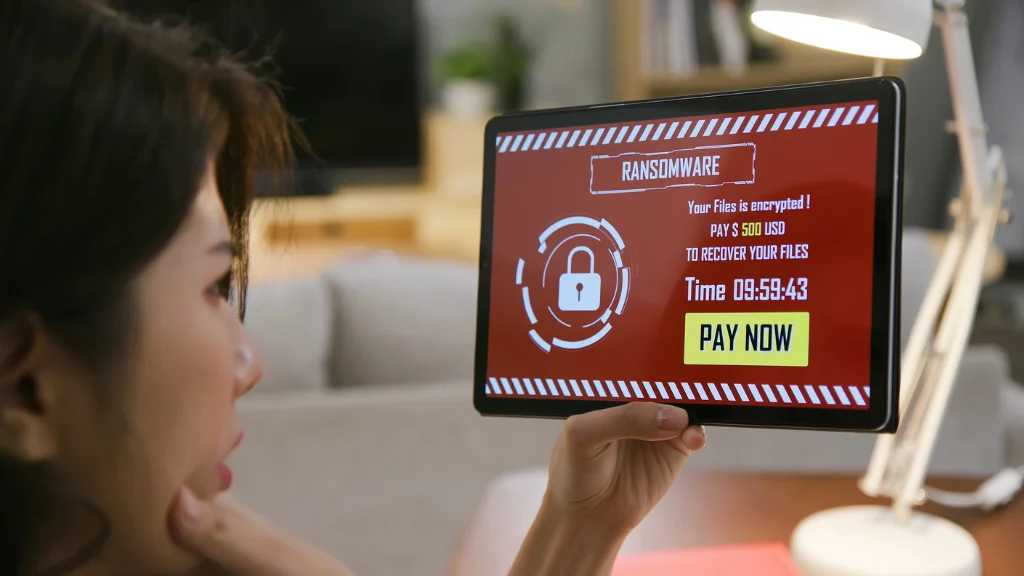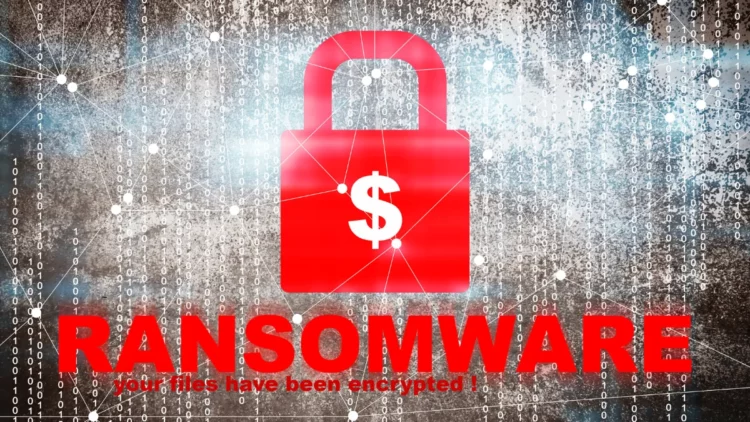In the annals of cyber threats, ransomware holds a particularly sinister reputation. This breed of malware doesn’t just steal or corrupt; it kidnaps, holding vital information hostage until victims pay a heavy price. Yet, amidst countless attacks, a few stand out for their sheer magnitude and impact. In this article, we chronicle the biggest ransomware attacks in history, providing an in-depth look into the mechanisms, motives, and mayhem they’ve unleashed. Step into the digital crime scene with us, as we unravel the stories behind the most devastating cyber extortions ever witnessed.
Here’s a List of 16 Biggest Ransomware Attacks in History
1. Ryuk
Emerging as a menacing cyber threat in 2018, the Ryuk ransomware has since been a persistent thorn in the side of global organizations, particularly targeting the healthcare sector and local municipalities. Distinctively, Ryuk doesn’t rely on widespread random distribution, as seen in many of its contemporaries. Instead, it employs a more calculated approach. Initially compromising networks, often through TrickBot infections, attackers patiently and stealthily map out the entire network, exfiltrate essential data, and amass credentials. Only once this meticulous groundwork is completed do they deploy Ryuk, ensuring its devastating effectiveness.
The encryption protocols used by Ryuk, namely RSA-2048 and AES-256, are formidable. They render the encrypted data inaccessible without the corresponding decryption keys. Expanding its reach, Ryuk maliciously encrypts network drives, resources, and even remote hosts, making recovery exceptionally challenging. The audacity and success of Ryuk attacks are underscored by its staggering ransom demands, which vary from 15 to 500 Bitcoin, translating to amounts between roughly $100,000 and $3.7 million. Communities like Jackson County in Georgia weren’t spared, having to part with $400,000.
Meanwhile, Riviera Beach in Florida and LaPorte County in Indiana saw ransoms of $594,000 and $130,000 respectively. Yet, not everyone conceded to these demands. Places like Bedford, MA, and New Orleans displayed resilience by refusing to pay the ransoms. As for the culprits, while the exact perpetrators remain elusive, fingers often point toward Wizard Spider, a group believed to operate out of Russia.
2. DoppelPaymer
Another one of the biggest ransomware attacks of all time, DoppelPaymer, burst onto the cybercrime scene in 2019, quickly establishing itself as a formidable adversary to institutions worldwide. What sets this malicious software apart is its modus operandi. Rather than relying on indiscriminate mass distribution, like most ransomware types, DoppelPaymer is manually deployed following a strategic compromise of the target’s network. Attackers meticulously map the infrastructure, exfiltrate crucial data, and escalate privileges, laying the groundwork for the ransomware’s maximum devastation when finally released.
DoppelPaymer is ingeniously designed for efficiency. It employs multi-threading techniques, ensuring swift encryption of victims’ files. Additionally, its capability to function offline, encrypting data without requiring communication with its command and control servers, adds another layer of complexity to its operations. Some of the most high-profile victims of DoppelPaymer include the City of Torrance, CA, the Mexican Oil giant Pemex, and notably, the University Hospital in Düsseldorf. The latter case was particularly tragic, as the ransomware’s disruption led to the unfortunate death of a patient.
In terms of financial extortion, ransoms demanded have varied widely from 2 to 100 Bitcoin, and in some cases, the fallout extends beyond just the ransom payment, as stolen data finds its way into the murky waters of the dark web, fetching a hefty price. With Europol estimating the group’s monetary impact to be at least €40 million, the DoppelPaymer Group’s influence in the world of cyber threats is undeniably significant.
See Also: How to Remove jZip Virus (by Bandoo)
3. Colonial Pipeline
In 2021, the Colonial Pipeline faced a significant ransomware attack orchestrated by the DarkSide group, which disrupted the U.S. oil infrastructure. Leveraging the DarkSide RaaS, they targeted the computer systems managing the pipeline, crippling the fuel distribution network from Texas to the Southeast. This resulted in widespread gas shortages, particularly in the Southeastern states, causing panic among Americans.
The severity of the attack caught the attention of federal and state officials, including President Joe Biden, who promptly issued emergency declarations. To address the vulnerabilities exposed by the attack, an executive order aimed at enhancing the country’s cybersecurity posture was issued. By the end, while the ransom was set at $4.4 million, the U.S. Department of Justice managed to recover approximately $2.3 million of it.
4. Costa Rica
In 2022, Costa Rica faced a prolonged onslaught from the Conti ransomware gang, marking one of the recent ransomware attacks that lasted several months. This meticulous attack targeted major government entities such as the Ministry of Finance, the Ministry of Science, Innovation, Technology, and Telecommunications, as well as the Ministry of Labor and Social Security. As a result of the cyber onslaught, the government was compelled to deactivate numerous systems, causing significant disruptions in trade, government payments, and various services.
Although the ransom amount was pegged at $10 million, the Costa Rican President, Carlos Alvarado, resisted paying. In retaliation, the Conti gang released almost all of the 672 GB of stolen data. It wasn’t until the intervention of the newly elected president, Rodrigo Chaves Robles, and his declaration of a state of emergency that the situation began to stabilize.
5. SamSam

Spanning the years 2016 to 2018, the SamSam ransomware campaign stood out due to its unique, targeted approach to cyberattacks. Instead of harnessing an automated, scattergun approach, the culprits behind SamSam adopted a more calculated method. Upon gaining unauthorized access to networks, either by exploiting the vulnerabilities in JBoss servers or by manipulating flaws in VPNs or RDP connections, the attackers would discreetly navigate through the system. Their modus operandi involved elevating their system privileges and subsequently spreading across the network, before finally unleashing the ransomware, catching their victims off-guard.
Among the over 200 victims that fell prey to SamSam were prominent entities like the city of Atlanta and Hancock Health, each grappling with the dire aftermath of the attack. Ransom demands from the attackers were typically steep, often crossing the $50,000 mark. Beyond the immediate financial hit of the ransom, the victims suffered long-term operational disruptions.
For instance, the city of Atlanta, which faced extensive damages to its digital infrastructure, had to allocate a whopping $2.6 million for recovery processes. The duo from Iran, Faramarz Shahi Savandi and Mohammad Mehdi Shah, believed to be the masterminds behind the SamSam campaign, were eventually indicted by the US, drawing the curtains on one of the most impactful ransomware campaigns of the time.
6. Impresa
Impresa, the largest media conglomerate in Portugal, found itself at the mercy of the Lapsus$ ransomware group in early 2022. This crippling attack led to the shutdown of all its digital channels, websites, weekly newspapers, and even its television networks. Moreover, the attackers commandeered Impresa’s Twitter account, further demonstrating their dominance.
In their public communications, Lapsus$ threatened to leak the conglomerate’s data. Although no direct ransom was demanded, the implications were clear. The Portuguese authorities classified this as the country’s most severe cyber attack, underscoring the necessity of advanced cybersecurity measures in the modern age.
Also Read: How to Get Rid of Soap2Day Virus?
7. JBS USA
JBS USA, a leading beef manufacturer, faced a daunting challenge in 2021 when the REvil group attacked their operations. This intrusion disrupted their systems and also affected Pilgrim’s Pride Corp., a subsidiary of JBS. The attackers’ tactics bore fruit when the company caved and paid an $11 million ransom in Bitcoin.
Though their IT staff acted swiftly to notice irregularities with the servers, the damage was done. Operations were temporarily halted, and even after paying the substantial ransom, it took days before JBS could resume regular activities, showcasing the profound impact ransomware can have on businesses.
8. Kronos
Ultimate Kronos Group, a global workforce management software maker, suffered a significant ransomware attack in late 2021. The attack not only disrupted their services but had repercussions for their clients, who faced challenges in processing payments to their workforce due to interruptions in the Kronos system.
Upon investigation, it was found that before the ransomware attack, malefactors had accessed the company’s cloud, pilfering corporate data. This breach exposed confidential employee data from numerous enterprise clients. The ramifications of this breach went beyond financial losses, drawing attention to the importance of third-party risk management and vendor accountability.
You might be surprised by the financial repercussions of the ransomware attack on Kronos. Following the 2021 cyber assault on its Kronos Private Cloud service, UKG consented to a class-action lawsuit settlement, setting aside up to $6 million for affected individuals.
9. Locky
Between 2016 and 2018, the digital realm experienced the rise of Locky, one of the biggest ransomware attacks worldwide. This nefarious malware stood apart due to its highly effective delivery mechanism: seemingly innocuous phishing emails containing malicious Word documents. Unsuspecting victims, upon opening these documents and activating macros, inadvertently set off the ransomware’s malicious payload. With a tactical combination of RSA and AES encryption methods, Locky encrypted a vast array of file types, making them virtually inaccessible.
The severity of Locky’s potential damage was further intensified by its ability to reach out and encrypt files shared across networks. In its heyday, this ransomware was responsible for paralyzing numerous healthcare providers, especially in countries like the US, Canada, France, Japan, Korea, and Thailand. When files were encrypted and file names muddled, victims were confronted with a stark choice: pay a ransom, typically ranging from 0.5 to 1 Bitcoin, or lose their invaluable data.
The alleged perpetrators behind Locky, speculated to be the infamous Dridex hackers or also known as Evil Corp or TA505, have managed to siphon an estimated $1 billion through this nefarious scheme. The tale of Locky serves as a chilling reminder of the ever-evolving cyber threats and the necessity of robust cybersecurity protocols.
10. Maersk

In 2017, A.P. Moller-Maersk, a Danish shipping behemoth, became a prime target of the notorious NotPetya attacks. This malware, exploiting a Windows vulnerability, wreaked havoc on Maersk’s operations, causing roughly $300 million in damages. The company was locked out from its systems, hindering operations across its global shipping terminals.
NotPetya was particularly destructive as it not only encrypted files but wiped them out entirely, rendering them irretrievable. Maersk’s ordeal lasted two weeks, after which they managed to restore their computer systems. The attack highlighted the importance of timely software updates and rigorous cybersecurity measures.
11. Swissport
In 2022, Swissport, a pivotal player in airport ground and cargo handling services, revealed that it was one of the companies affected by ransomware attacks on its systems. The incident, though contained within a day, had noticeable impacts. Few flights faced delays, but the real concern arose when the BlackCat ransomware group claimed responsibility.
BlackCat didn’t just stop at encryption. They declared possession of 1.6 TB of Swissport’s data, threatening to sell it, which is a clear indication of a double extortion strategy. Such tactics underline the growing sophistication of ransomware attackers and the challenges businesses face in dealing with them.
12. Travelex
At the end of 2019, Travelex, then the world’s largest foreign exchange bureau, became a victim of the REvil ransomware gang. This group capitalized on a known vulnerability to breach the company’s systems and encrypt significant amounts of data. Originally, a staggering $6 million was demanded in ransom.
However, the fallout from the attack was considerable. Even after negotiating the ransom down to $2.3 million, the company’s internal systems were offline for nearly two weeks. This financial turmoil was a key factor that pushed the company into administration the subsequent year.
See Also: How to Fix DNS_PROBE_FINISHED_NO_INTERNET Issue
13. GandCrab
In the realm of cyber threats, 2018 introduced the world to GandCrab, a uniquely commercialized ransomware variant. Operating under the Ransomware-as-a-Service (RaaS) model, GandCrab exemplified a shift in the cybercrime ecosystem. Rather than relying on a solitary group of attackers, GandCrab’s developers licensed out their malicious tool to a myriad of affiliates. These affiliates, in turn, launched their individual attacks, but crucially, shared a cut of their illicit gains with the GandCrab architects. This franchise-like operation method made GandCrab not only prolific but also one of the most financially damaging ransomware campaigns.
The infection vectors for GandCrab were manifold. Phishing emails remained a primary vehicle, luring unsuspecting victims to unknowingly execute the ransomware. Moreover, exploit kits, notably the GrandSoft and RIG kits, amplified its distribution. Once entrenched in a victim’s MS Windows PC, GandCrab would spring into action, encrypting invaluable files. In a twist from other ransomware, victims found themselves compelled to pay a ransom in the Dash cryptocurrency, rather than the more commonly demanded Bitcoin.
While the operators behind GandCrab announced their ‘retirement’ in 2019, the aftermath of their operations, with extortions surpassing $2 billion, underscores the profound impact of this ransomware variant. The GandCrab episode serves as a clarion call for businesses and individuals alike, emphasizing the paramount importance of cyber vigilance and robust defenses.
14. UK National Health Service

The WannaCry ransomware attack in spring 2017 impacted numerous companies globally, but the UK’s National Health Service (NHS) was among its most high-profile victims. This ransomware, exploiting a Windows flaw, affected several healthcare facilities in England and Scotland, causing interruptions in medical services.
Although no fatalities were directly linked to the cyberattack, the disruptions in health services were significant. The attack emphasized the paramount importance of cybersecurity in sectors like healthcare, where lives can be directly affected.
15. Ukraine
In 2017, Ukraine bore the brunt of the global NotPetya attacks, accounting for approximately 80% of the total incidents. Various sectors, including the nation’s computer systems, private company networks, and electric utilities, were severely impacted. This series of attacks also included the aforementioned Maersk incident.
Attributed to Russia’s GRU military spy agency by the CIA, the attack is estimated to have caused $10 billion in damages globally. With Ukraine being the epicenter, it underscored the geopolitical implications of ransomware and cyber warfare in the modern era.
16. CryptoLocker
Active between 2013-2014, CryptoLocker was a notorious ransomware that spread via malicious email attachments. Once activated, it encrypted victims’ files, demanding ransoms of around $300 in Bitcoin or prepaid vouchers for decryption. Unique for its advanced encryption methods and decentralized command via the Gameover ZeuS botnet, it was virtually unbeatable at the time.
The malware was attributed to Evgeniy Mikhailovich Bogachev, a Russian national now wanted by the FBI, and its impact led to an estimated $3 million in ransom payments. It was neutralized in May 2014 by Operation Tovar, a combined effort of global cybersecurity experts and law enforcement.
Learn More: Is Y2Mate YouTube Downloader Safe?
What Is the Most Common Method to Infect Your Computer With Ransomware?
The primary vector for ransomware infections is typically phishing emails containing harmful attachments. Another prevalent method is ‘drive-by downloads,’ where unsuspecting users visit compromised websites, leading to the silent and unintentional download of malware onto their systems.
Should You Turn off the Computer in Ransomware?
If you suspect a ransomware infection and cannot address it promptly, shut down the computer to prevent potential further harm by the malware. When rebooting, always initiate in Safe Mode. This mode allows you to access fundamental system functions without enabling the ransomware to inflict additional damage or spread further.
Best Tips to Keep Your System Safe From Ransomware Attacks
To best safeguard your system against ransomware attacks, adopt a multi-layered defense strategy. Always maintain up-to-date software and operating systems to patch vulnerabilities. Implement robust antivirus and firewall protection. Regularly backup essential data to offline or cloud storage, ensuring backups are not directly connected to your primary system.
Be wary of unsolicited emails, especially those with attachments or links; these are often phishing attempts. Educate users about the dangers of clicking on unknown links or downloading dubious files. Finally, restrict user permissions, so not everyone has access to all parts of your system. Proactive vigilance is the key to minimizing ransomware risks.






